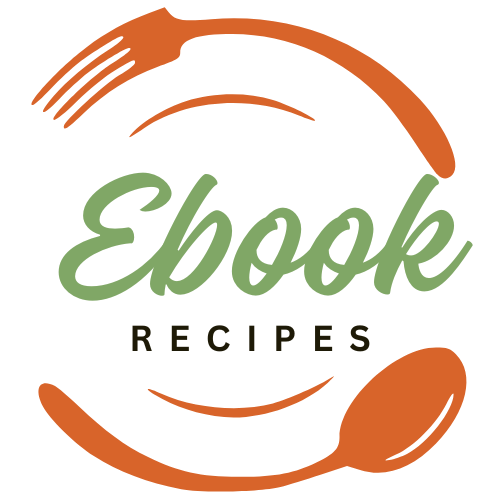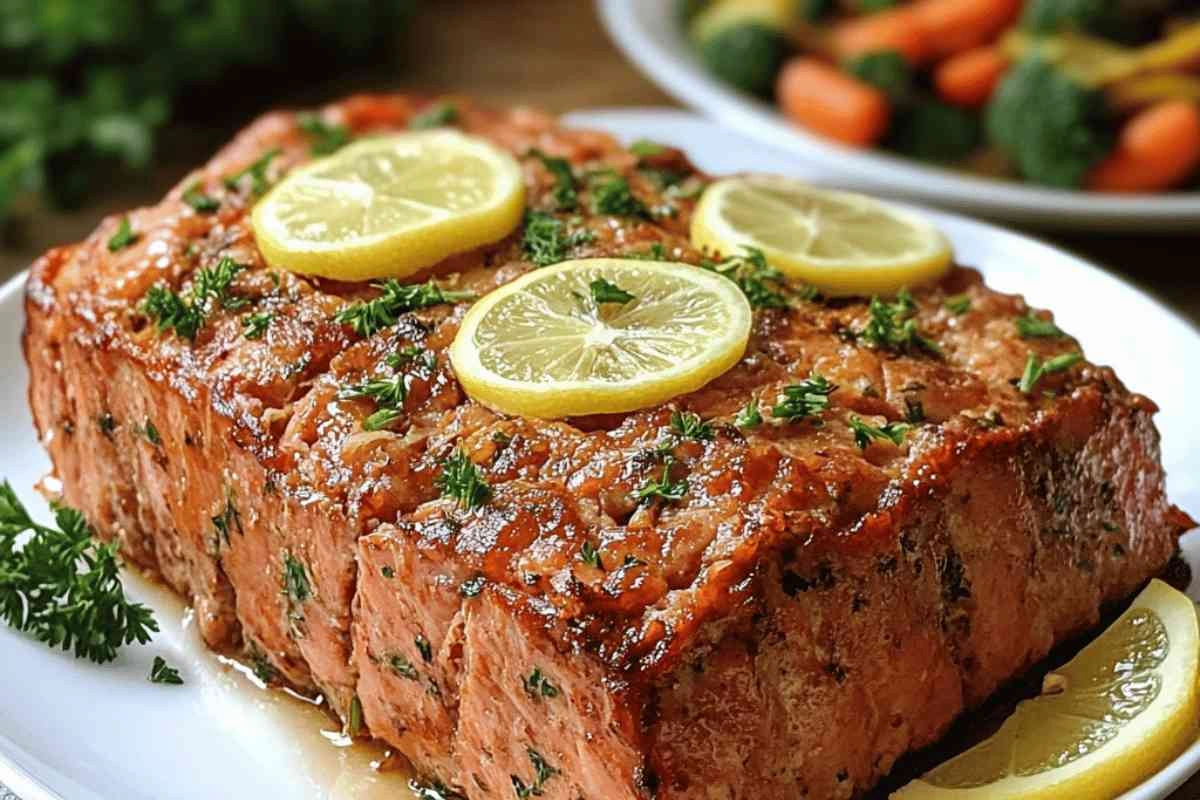Can tuna and salmon be used in the same loaf recipe? The answer is a delicious yes! These two seafood staples not only complement each other’s flavors but also offer a unique texture combination perfect for a loaf recipe. Whether you’re whipping up a family dinner or trying something new for meal prep, combining canned tuna and salmon creates a nutritious, protein-packed dish that’s easy to make and full of flavor. In this guide, we’ll explore why tuna and salmon work beautifully in a loaf recipe, share a fail-proof recipe, and answer popular questions about using these two ingredients together.
“If you’ve ever wondered, ‘can tuna and salmon be used in the same loaf recipe?’, this guide is here to provide the answer and much more.”
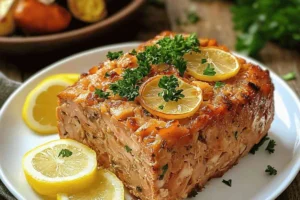
Exploring the Compatibility of Tuna and Salmon
Does Tuna Complement Salmon in a Loaf?
Tuna and salmon in one recipe? Why not! The combination might sound unconventional, but their flavors and textures balance each other surprisingly well. Tuna offers a firm, meaty texture, while salmon provides a flaky, rich quality that makes the loaf moist and flavorful.
Here’s why they’re compatible:
- Flavor Balance: Tuna has a milder taste, which complements the buttery richness of salmon.
- Texture Synergy: The firm texture of tuna helps the loaf hold together, while salmon’s softness adds moisture.
Key Benefits of Combining Tuna and Salmon
When you combine these two fish, you get the best of both worlds:
- Nutritional Boost:
- Tuna is rich in lean protein.
- Salmon is loaded with omega-3 fatty acids and vitamins.
- Cost-Effective:
- Combining two types of canned fish helps cut costs while still delivering a gourmet dish.
- Culinary Creativity:
- Mixing tuna and salmon opens the door to experimenting with seasonings and side dishes.
The Science Behind Using Tuna and Salmon Together
Balancing the Textures of Tuna and Salmon
Tuna and salmon each bring unique textures to the table, making them a dynamic duo for a loaf recipe. Tuna’s firm and slightly dry texture contrasts with salmon’s moist, flaky quality. When combined, they create a balanced consistency that holds the loaf together while remaining tender and flavorful.
Here’s how to achieve the perfect texture balance:
- Ratio Matters: Use a 1:1 ratio of tuna to salmon for even distribution of textures.
- Choose High-Quality Cans: Opt for premium canned fish packed in water or olive oil to avoid an overly oily loaf.
- Binders Make a Difference: Incorporate eggs and breadcrumbs to help the loaf hold its shape and maintain moisture.
Flavor Pairing Tips
To ensure your tuna and salmon loaf doesn’t taste overpowering or bland, consider these flavor-enhancing tips:
- Spices and Herbs: Dill, parsley, and garlic pair well with both tuna and salmon.
- Acidity: A squeeze of lemon juice brightens the flavors and neutralizes any fishy aftertaste.
- Cheese Options: A sprinkle of parmesan or cheddar can add a savory depth.
Cooking Science: What Happens When They Cook Together
When baked, the combination of tuna and salmon creates a perfectly moist loaf. The fat from salmon renders as it cooks, infusing the loaf with flavor, while tuna adds structure.
- Bake at 375°F (190°C) for 40–50 minutes to ensure even cooking.
- Use a meat thermometer to check the internal temperature—aim for 145°F (63°C).
Recipe—Tuna and Salmon Loaf
Ingredients You’ll Need
To create a delicious tuna and salmon loaf, gather the following ingredients:
- Protein:
- 1 can (6 oz) tuna, drained
- 1 can (6 oz) salmon, drained and deboned
- Binders:
- 2 large eggs
- 1 cup breadcrumbs (panko or regular)
- Flavor Enhancers:
- 1 small onion, finely diced
- 2 cloves garlic, minced
- 2 tablespoons fresh parsley, chopped
- 1 teaspoon dried dill
- 1 teaspoon paprika
- ½ teaspoon black pepper
- ½ teaspoon salt
- Moisture and Balance:
- ½ cup milk (or unsweetened almond milk)
- 1 tablespoon lemon juice
- Optional Add-Ins:
- ½ cup grated parmesan cheese
- 1 small carrot, finely grated
Step-by-Step Instructions
- Preheat and Prepare:
Preheat your oven to 375°F (190°C). Lightly grease a loaf pan or line it with parchment paper for easy removal. - Mix Ingredients:
In a large mixing bowl, combine the drained tuna and salmon. Flake the fish using a fork to ensure even distribution. Add breadcrumbs, eggs, onion, garlic, parsley, dill, paprika, black pepper, and salt. - Add Moisture:
Slowly pour in the milk and lemon juice, mixing gently until the ingredients form a cohesive mixture. If the mixture feels too dry, add an extra tablespoon of milk. - Optional Add-Ins:
Fold in grated parmesan cheese and carrot for added texture and flavor. - Shape and Transfer:
Transfer the mixture to the prepared loaf pan. Press down gently to ensure the loaf is compact and evenly shaped. - Bake:
Place the loaf pan in the oven and bake for 40–50 minutes, or until the top is golden brown and the loaf is firm to the touch. - Cool and Serve:
Let the loaf cool for 10–15 minutes before slicing. This helps it hold its shape.
Serving Suggestions
Pair your tuna and salmon loaf with these delicious sides:
- A crisp green salad with a light vinaigrette.
- Steamed asparagus or roasted vegetables.
- A dollop of tartar sauce or spicy aioli for dipping.
Substituting Ingredients in a Loaf Recipe
Can Salmon Be Substituted for Tuna?
Yes, salmon can replace tuna in most loaf recipes, but it may slightly change the flavor and texture of the dish. Here’s what to keep in mind:
- Texture Adjustments:
Salmon is naturally softer and flakier than tuna. If replacing tuna entirely, consider reducing the liquid (e.g., milk or broth) slightly to maintain the loaf’s structure. - Flavor Profile:
Salmon’s rich, buttery taste can overpower other ingredients, so balance it with acidic elements like lemon juice or vinegar.
Other Proteins You Can Use in a Loaf Recipe
If you’re out of canned tuna or salmon, try these alternatives:
- Canned Chicken:
Provides a mild flavor and firm texture, making it an easy substitute. - Mackerel or Sardines:
Adds a bolder, more robust flavor. Ideal for adventurous palates. - Plant-Based Options:
Use mashed chickpeas, lentils, or jackfruit for a vegetarian or vegan alternative.
What Else Can You Mix with Tuna and Salmon?
Here are some creative add-ins to elevate your loaf recipe:
- Vegetables:
- Grated zucchini or carrots for added moisture.
- Finely diced bell peppers for a crunch.
- Grains:
- Cooked quinoa or rice for added bulk and texture.
- Cheese:
- Cheddar, mozzarella, or even feta for a creamy, savory twist.
- Nuts and Seeds:
- Chopped walnuts or sunflower seeds for a crunchy texture.
Tips for Experimenting with Substitutes
- Test small batches with different substitutions to find your perfect combination.
- Adjust cooking times slightly for wetter or denser ingredients.
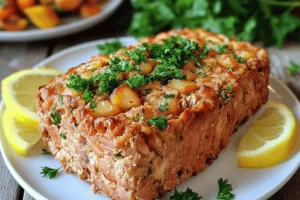
Common Mistakes to Avoid
Overpowering Flavors
One common mistake when combining tuna and salmon is letting one fish overpower the other. Here’s how to avoid this:
- Balance the Ratio: Stick to a 1:1 ratio of tuna to salmon for an even flavor profile.
- Season Thoughtfully: Use complementary spices like parsley, dill, and paprika to harmonize the flavors.
- Avoid Over-Spicing: Excessive seasoning can mask the natural taste of the fish.
Using the Wrong Binders
Binders are essential for holding the loaf together. Common errors include:
- Skipping Eggs or Breadcrumbs: Without proper binders, the loaf can fall apart during baking.
- Using Too Much Liquid: Overhydrating the mixture can make it mushy and difficult to slice.
Pro Tip: Aim for a texture that holds its shape when pressed but isn’t overly sticky.
Overcooking the Loaf
Overbaking can dry out the loaf and diminish its flavor. Avoid this mistake by:
- Using a Timer: Bake at 375°F (190°C) for 40–50 minutes and check for doneness.
- Monitoring Internal Temperature: The loaf is done when it reaches an internal temperature of 145°F (63°C).
Not Allowing It to Rest
Cutting the loaf immediately after baking can cause it to crumble. Let it rest for 10–15 minutes to set properly before slicing.
Nutritional Benefits of Tuna and Salmon
Why Tuna and Salmon Are Nutritional Powerhouses
Tuna and salmon are not just delicious; they’re also loaded with essential nutrients that support overall health. Combining them in a loaf recipe creates a meal that’s both hearty and nutritious.
Nutritional Highlights of Tuna:
- High-Quality Protein: Tuna provides a lean protein source that supports muscle health and repair.
- Low in Fat: Ideal for low-fat diets, tuna offers a rich source of energy without extra calories.
- Vitamins and Minerals: Packed with B vitamins (like B6 and B12), which promote brain health, and selenium, an antioxidant.
Nutritional Highlights of Salmon:
- Omega-3 Fatty Acids: Known for improving heart health and reducing inflammation.
- Rich in Healthy Fats: Unlike tuna, salmon contains more heart-healthy unsaturated fats.
- Vitamin D: Supports bone health and boosts immune function.
How Tuna and Salmon Complement Each Other
When combined, tuna and salmon provide a well-rounded nutritional profile:
- Protein Synergy: The combination offers more balanced amino acids.
- Healthy Fats: Salmon’s omega-3s complement tuna’s lean protein, making the loaf satisfying and energy-rich.
- Vitamin Diversity: Together, they deliver a mix of essential vitamins like B12, D, and E.
Serving Size and Calorie Breakdown
A standard serving of tuna and salmon loaf (about 1 slice) typically contains:
- Calories: 200–250
- Protein: 20–25 grams
- Fat: 10–12 grams (mostly unsaturated)
- Carbs: 5–7 grams (from breadcrumbs or grains)
Tips for Choosing the Right Canned Fish
How to Select Quality Canned Tuna and Salmon
Choosing the right canned fish is key to creating a flavorful and nutritious loaf. Here are some tips to help you pick the best options:
For Canned Tuna:
- Type of Tuna: Look for light or skipjack tuna for a milder flavor or albacore tuna for a firmer texture.
- Packaging: Choose tuna packed in water for lower calories or in olive oil for added flavor and healthy fats.
- Sodium Content: Check the label for low-sodium options to control the salt level in your dish.
For Canned Salmon:
- Bone and Skin Options: Opt for boneless and skinless canned salmon for convenience or keep them for added calcium and flavor.
- Wild-Caught vs. Farm-Raised: Wild-caught salmon tends to have a richer flavor and more omega-3s.
- Sustainability: Look for eco-friendly certifications like MSC (Marine Stewardship Council).
Reading Labels for Important Information
Understanding what’s in your canned fish is crucial:
- Ingredients List: Avoid products with unnecessary additives or preservatives.
- Expiration Date: Always check the date to ensure freshness.
- Country of Origin: High-quality canned fish often comes from regions known for sustainable practices.
Sustainability Factors to Consider
To support environmentally friendly practices:
- Eco-Certifications: Look for labels like MSC or Dolphin Safe.
- Packaging Materials: Select brands that use BPA-free cans to avoid harmful chemicals.
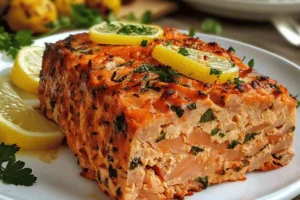
FAQs About Tuna and Salmon
Can Tuna and Salmon Be Used in the Same Loaf Recipe?
Yes, salmon and tuna complement each other beautifully in recipes like loafs, salads, or casseroles. Salmon’s rich, buttery flavor balances tuna’s mild taste, creating a harmonious blend. Their contrasting textures—tuna being firm and salmon flaky—add to the dish’s appeal.
Can You Substitute Salmon for Tuna in a Recipe?
Absolutely! Salmon is a great substitute for tuna in most recipes, including loafs. However, a few considerations apply:
- Flavor: Salmon has a more distinct taste compared to tuna, so adjust seasonings accordingly.
- Texture: If replacing tuna entirely with salmon, reduce liquid ingredients slightly to avoid a mushy loaf.
What Else Can You Mix With Tuna?
Tuna is incredibly versatile and pairs well with various ingredients:
- Vegetables:
- Finely chopped celery, bell peppers, or grated zucchini.
- Proteins:
- Hard-boiled eggs or even other fish like shrimp.
- Grains and Legumes:
- Cooked quinoa, rice, or chickpeas can bulk up the recipe.
- Dairy:
- A dollop of cream cheese or a sprinkle of shredded cheddar.
Is Canned Salmon the Same as Canned Tuna?
While both are canned fish, they differ significantly:
- Taste:
- Tuna has a milder, meatier flavor.
- Salmon offers a richer, buttery taste.
- Nutritional Content:
- Tuna is higher in protein and lower in fat.
- Salmon provides more omega-3 fatty acids and vitamin D.
- Appearance:
- Canned tuna is usually white or light pink, while canned salmon has a darker, reddish hue.
Serving Suggestions for Tuna and Salmon Loaf
Perfect Side Dishes for Tuna and Salmon Loaf
Pairing your tuna and salmon loaf with the right sides enhances the overall dining experience. Here are some simple yet delicious options:
- Vegetables:
- Roasted Vegetables: Carrots, zucchini, and asparagus roasted with olive oil and garlic.
- Steamed Greens: Broccoli, green beans, or spinach for a light and healthy pairing.
- Salads:
- Classic Green Salad: Tossed lettuce, cucumbers, and cherry tomatoes with a tangy vinaigrette.
- Potato Salad: A creamy potato salad with dill and mustard complements the loaf’s flavor.
- Grains:
- Quinoa: A side of fluffy quinoa enhances the dish’s nutritional value.
- Rice Pilaf: Lightly seasoned rice with herbs or lemon zest.
Dipping Sauces and Condiments
Add a touch of flavor with these accompaniments:
- Tartar Sauce: A classic seafood pairing.
- Spicy Aioli: A blend of mayonnaise, garlic, and sriracha for a zesty kick.
- Lemon Butter Sauce: Simple yet luxurious, this sauce pairs wonderfully with the loaf.
Storage and Reheating Tips
- Refrigeration: Store leftover loaf in an airtight container for up to 3 days.
- Freezing: Wrap slices individually in plastic wrap and store in a freezer bag for up to 2 months.
- Reheating: Warm in an oven at 350°F (175°C) for 10–15 minutes to maintain its texture.
Conclusion: A Culinary Duo Worth Trying
Why Tuna and Salmon Shine Together
Combining tuna and salmon in a single loaf recipe might seem unconventional, but it’s a match made in culinary heaven. The contrast in their textures and flavors creates a balanced, flavorful dish that’s nutritious and easy to prepare. From their complementary nutritional benefits to their budget-friendly appeal, this duo proves that opposites truly attract in the kitchen.
Tuna brings its lean, firm qualities, while salmon adds richness and moisture. Together, they form a loaf that’s perfect for family dinners, meal prep, or even a dish to impress guests.
Try It Today!
If you’ve been hesitant to combine tuna and salmon, this guide should put your doubts to rest. With tips, a recipe, and serving suggestions, you’re ready to experiment with this unique pairing. So, grab your ingredients, fire up the oven, and prepare to wow your taste buds!
Don’t forget to explore more creative seafood recipes on our website: eBookRecipes.com.
